
Six vital modules for every digital onboarding concept
A blueprint for efficient onboarding with lasting impact
Different companies have different requirements for their onboarding process. They might want to use modular and future-proof concepts, achieve cost and time savings compared to current approaches, or enable employees to start working sooner. Moreover, the pandemic has accelerated the need for digital onboarding as face-to-face training has not been possible. Despite the pandemic introducing more relaxed, remote working arrangements, hybrid work arrangements will become the norm; hence digital onboarding will become the tool to deliver a great first experience to new employees.
Yet, companies are not the only stakeholders – Employees have their own expectations of the onboarding process. This is why many HR managers are deciding on learner-centric onboarding that revolves around the needs of new employees:
“I want to know what makes my company tick,” – “I want to feel like I’m becoming part of the community,” – “I want to improve my skills.”
To achieve that, your onboarding needs a framework that provides guidance and an emotional connection while assessing the current state of knowledge and developing expertise.
This article explains how to design an exciting and creative digital onboarding process with new and existing e-learning content, even without a learning management system (LMS).

An illustration of the key building blocks
Our experts are always developing concepts suitable for a wide range of requirements. Get a head start with our “best of” compilation. Let’s imagine this situation: You want to digitise five days of basic training that has always been conducted on site. You are looking at a very diverse group of participants. The target group for this training extends beyond new colleagues, and also includes “old hands,” as well as some external service providers. They each have a different level of prior knowledge, different hardware, and different levels of access to a learning management system (LMS). Some might not have any access at all.
How do you satisfy them all? The solution is to design a structured framework for digital onboarding. Our experts recommend getting a head start with these 6 modules:
- A central (digital) starting point
- A daily virtual kick-off
- The self-learning phase
- A virtual hands-on workshop
- The online quiz
- A learning diary
Together, these six modules form a foundation. Let’s look at each element separately.
My Digital Onboarding Kit – The modules in detail
The central starting point could, for example, be a browser-based landing page created especially for onboarding, a homepage in the company intranet, a portal page (in the LMS) or an interactive PDF. It is important that the employees can see at a glance what is on the agenda for the day when they arrive for their onboarding. Think of it as a modern timetable. Every new employee needs structure, and an overview page is an easy way to provide that.
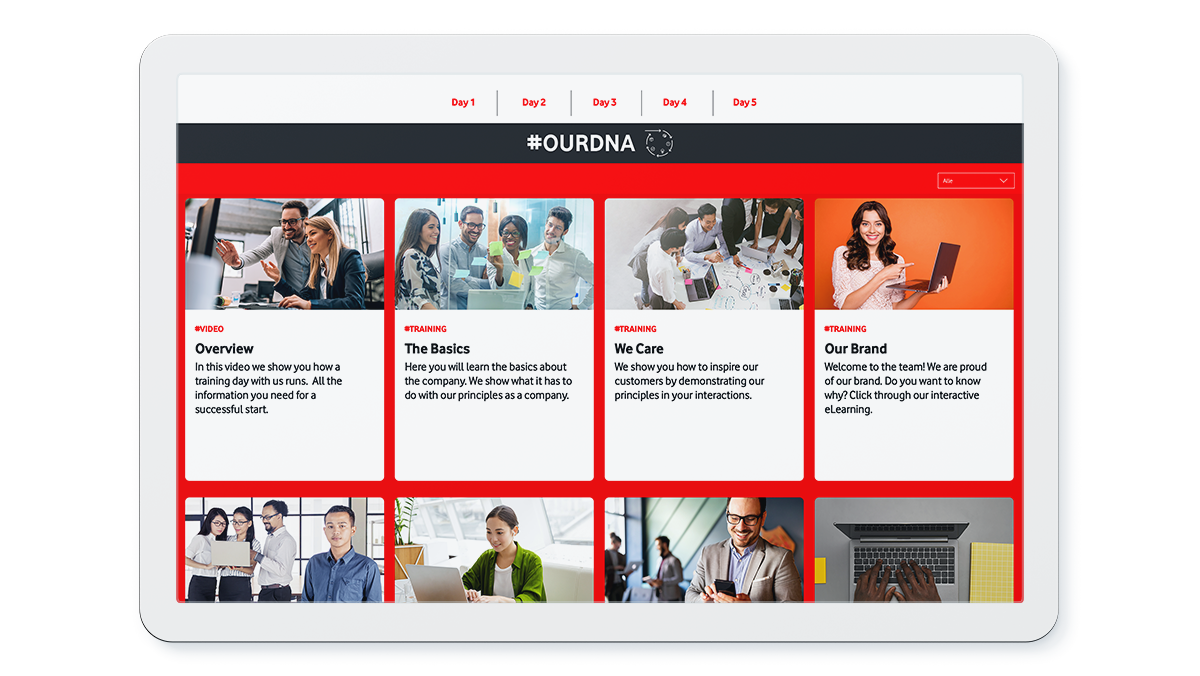
Portal page as central starting point
The virtual kick-off at the beginning of each training day serves to agree and discuss the agenda and objectives for the day together with the trainers. The focus should be on social onboarding, on promoting interaction between the participants. Our experts recommend a playful warm-up with surveys, icebreakers, or activation games aka energisers. Why not play a round of “I packed my bag” to get started? It is helpful to establish a meeting netiquette, specifying that cameras and microphones must be switched on.

virtual kick-off
In the self-learning phase, each learning format achieves a specific objective. For example, digital performance cards help employees gain knowledge with a certain focus, and then apply it in simulations as part of web-based training. Virtual scavenger hunts help them familiarise themselves with the company or the intranet. Companies can also integrate existing training courses or offer individually tailored or branded content. Variation between different e-learning formats has proven particularly effective.
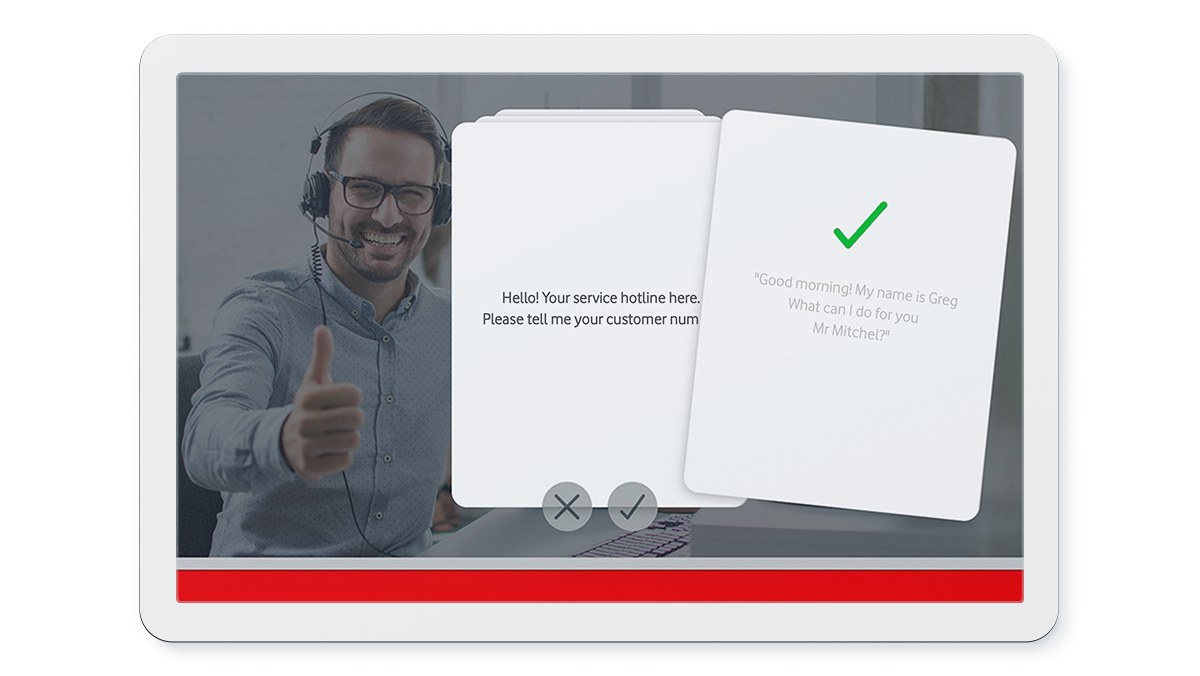
Performance cards
The hands-on workshop moderated by the trainers gives the employees an opportunity to apply what they learned and clarify any questions or uncertainties. This could include polls, multiple choice questions in the group chat or whiteboards.
The online quiz concludes the day. One great example is the BizQuiz. It provides participants with feedback on their learning progress and gives them the opportunity to close any knowledge gaps.
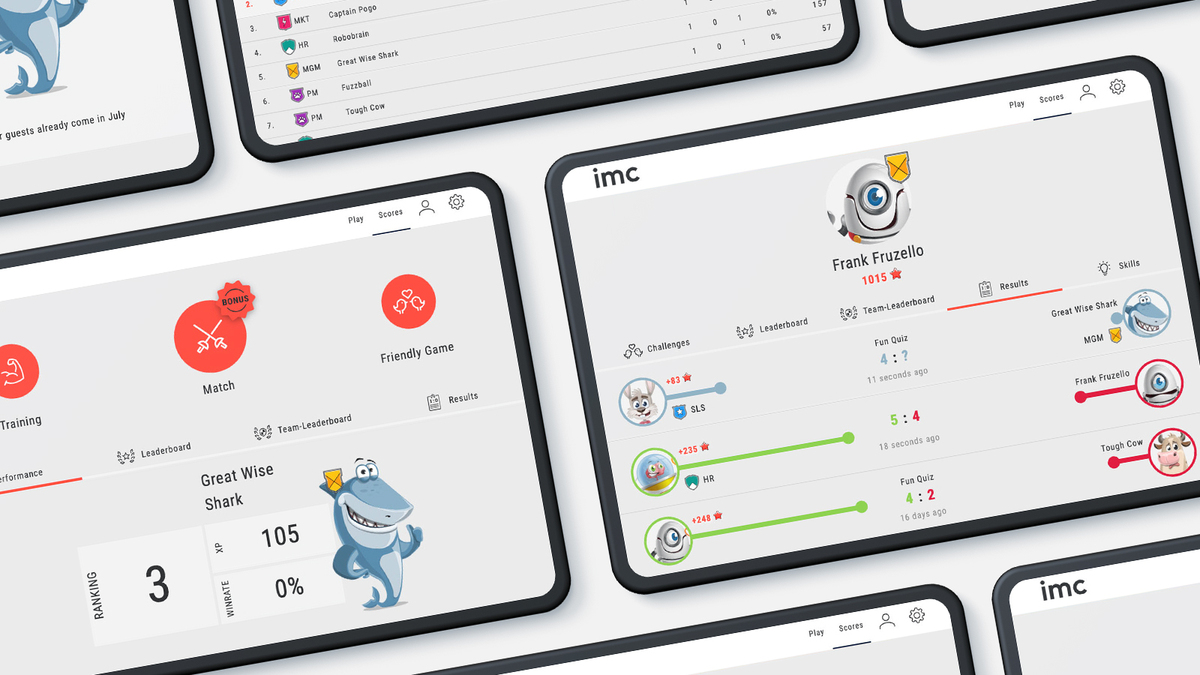
quiz app: Biz Quiz
Finally, the learner makes their personal entry in the learning diary. An easy way to integrate the diary is to design a page in the intranet, a document in the cloud or a form that mirrors the central starting point, and which each participant completes for themselves. This serves to summarise the core messages from the workshops or formulate the questions and tasks for the self-learning phase, as well as compiling key insights from the training courses. The personal learning diary thus becomes an individual reference resource participants can look things up in long after their onboarding.

Learning diary
GOOD TO KNOW
Time investment for trainers is automatically reduced
The targeted use of digital learning formats in the self-learning phase reduces time investment for trainers during digital onboarding. That saves costs and resources. Following this 6-module approach, trainers are only required for the kick-off and the workshop phase.
Digital vs hybrid onboarding
Digital onboarding works. This approach can absolutely be appropriate while also saving resources. Nevertheless, some onboarding processes are easier to realise in a hybrid format. Of course, that does require new employees to travel to the location.
One example for a good hybrid solution would be to communicate theoretical content through online self-study, and then bring participants on site to carry out specific actions, such as operating machinery. The face-to-face part of the training can then be utilised for practical exercises and to clarify questions.
Similarly, a dual approach helps with understanding the corporate culture. For instance, companies might invite new employees for an intro day before their first day of work. Make the most of this day by asking colleagues to talk about how they realise the values, objectives, and mission of the company in their daily work. This meeting can also be leveraged to establish an emotional connection with new recruits and build enthusiasm for the company.
In our experts’ experience, it is not as clear-cut as one approach being universally better. Rather, it is about selecting suitable formats and linking them in a helpful way based on the new employees’ needs and the learning objectives.
We linked a special treat for anyone interested in hybrid onboarding:

Digital Learning Journey
Reaching the destination with the right blend of formats: Digital learning journeys capitalise on the strengths of each learning format to create a motivating learning experience.

LMS Hot Topics: Science fiction or near future?
Onboarding can already be integrated into existing learning management systems. But Hanna's example shows that this is only the beginning.
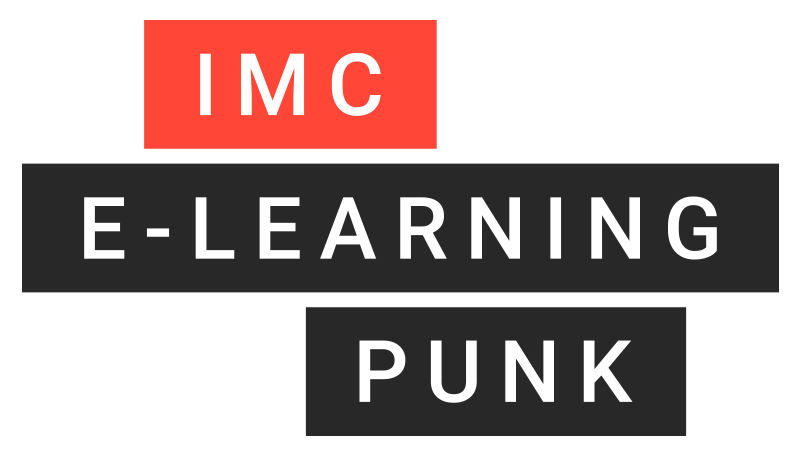
Contact person
I joined the imc newsroom team in 2021. As a journalist my heart beats for content and storytelling.
I’m excited to figure out how e-learing and digitization affect the future of work. My task is to create content to talk about and I’m always looking for trends.
Privately I love to travel and eat Tapas.
Topics: E-Learning Trends, Corporate Social Responsibility, Press and Influencer Relations

Rapid Content Development: Creating E-Learning Trainings Quickly
Why fast creating digital trainings is possible but risky
... and suddenly, the training had to be scrapped. Many companies made that experience in lockdown number one. Employees needed to be trained, but the training was postponed due to Corona. Again. And again. However, most types of training simply cannot be endlessly postponed or even be cancelled altogether.
A pragmatic and swift solution is needed – training needs go where the employees are: their home office. For many companies, that means digitising learning content, and doing so quickly. They need rapid content development. This trend was already apparent before Corona, but the pandemic greatly increased the demand for the technologies that facilitate rapid content development.
This article explores what qualifies as rapid content development, what type of learning content is suitable for rapid digitisation, and what risks a strong focus on speed entails.
INFO
Definition: Rapid content development (RCD) is an agile model for teaching system design, comprising a preparation phase, an iterative design, template-based re-usable components and e-learning tools for quick and cost-efficient provision.
Speedy please – but without quality loss
We want things now: fast food, coffee to go, messenger services, online shopping … we no longer have time. Companies have also clocked onto this trend, and want to stay up to date with their training courses. An ever-increasing amount of knowledge is expected to be available almost instantly on various media while maintaining a high quality standard and staying within budget.
The solution: rapid content development. But wait a minute! No matter how fast you go, the quality of the overall learning solution must not be compromised. That’s why learning experts like Eva Lettenbauer always look at the big picture.

Eva Lettenbauer, Specialist Learning Experience Design at imc
Hi Eva, thanks for “quickly” making time for us. How did you experience the rapid content development hype last year?
Especially at the beginning of the pandemic, many companies were facing the challenge of having to digitalise their face-to-face training in a short space of time. However, directly transitioning classroom-based training courses to a virtual classroom or web session is not always effective, and it’s most certainly not efficient.
That is why we always examine the specific issues and objectives. This allows us to digitise specific learning content in a way that drives outcomes and boosts performance.
How do you handle requests for “rapid” content?
Since requirements differ as widely as the type of knowledge to be conveyed, digital solutions vary enormously. We start by analysing the sharable knowledge and the desired outcome. We also examine if the integration of certain existing learning solutions or curated content would add value, and examine the suitability of different learning infrastructures. Finding the right formats for the content at hand has to be a priority, as this then allows new content to be created quickly and systematically.
What risks does rapid content development involve, and how do you avoid them?
There is a risk of quality loss – creating too much content while neglecting quality, or losing sight of the target group, their performance or the intended business outcome when designing and creating content. This can make the learning solution irrelevant and ineffective. Often, less is more. It pays to take a closer look and be more deliberate when starting the rapid content development process, and avoid such mistakes.

When would you recommend slowing down?
Whenever learning corresponds to behavioural changes, aims to change the learners’ mindset, or the branding, look or feel of the learning solution are important, investing time to achieve a high-quality solution is paramount. This is the only way to gain the learners’ lasting interest and make them believe in digital learning approaches.
GOOD TO KNOW
Authoring tools enable companies to create learning content themselves or digitise existing material. This facilitates a flexible response to learning requirements within the company.
Authoring tools are cost-effective and allow both internal experts and other employees to create training courses. This is also known as user generated content.
What are the limits for content creation with authoring tools?
Authoring tools like imcExpress are ideal for quickly creating and sharing content based on facts or background knowledge. Digital learning content can be created quickly and – crucially – kept up to date. However, no learner should be trained exclusively with web-based training courses. Especially if their development involves the application of specific practical skills, traditional web-based training is seldom enough – but that is all an authoring tool can deliver.
What would a worst-case scenario look like? How “not to” do it?
Worst case: 5 days of face-to-face classroom training is taken “as is” and squeezed into a 3-day training course in a virtual classroom. Endless recordings of face-to-face training or web sessions replace the on-site presentation of the material.
Best case: A 3-day face-to-face training course is digitalised and broken up into various learning nuggets like short web-based training courses, complemented with learning tandems, snappy web sessions and curated content.
How about a quick summary? Happy to be at your service:
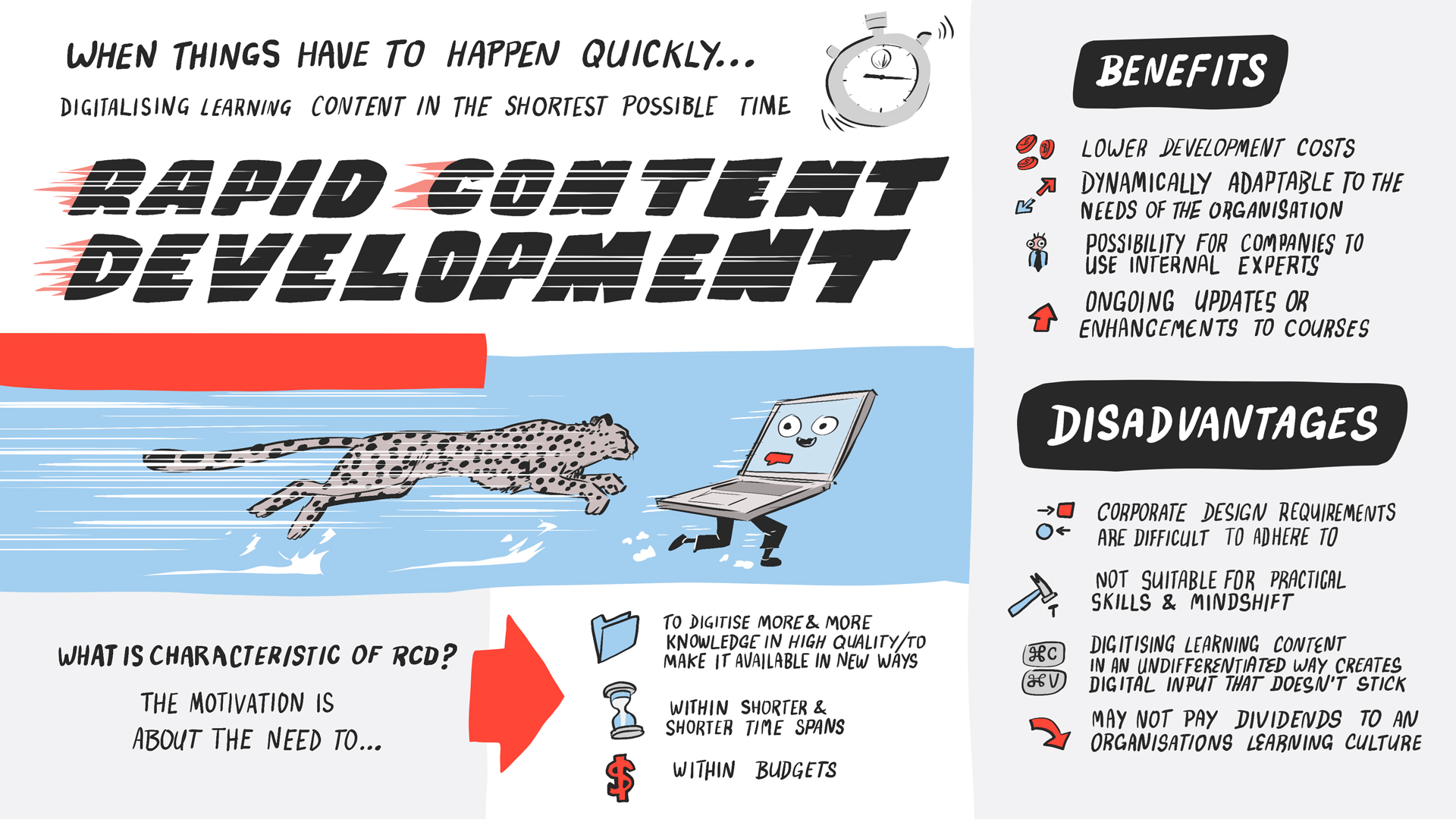

Digital Learning Journey
Reaching the destination with the right blend of formats: Digital learning journeys capitalise on the strengths of each learning format to create a motivating learning experience.

User-generated elearning content meets artificial intelligence
Creating learning content has nerver been that easy. Oliver Nussbaum and his team developed a new AI-driven authoring tool called imc Express.

Contact person
I joined the imc newsroom team in 2021. As a journalist my heart beats for content and storytelling.
I’m excited to figure out how e-learing and digitization affect the future of work. My task is to create content to talk about and I’m always looking for trends.
Privately I love to travel and eat Tapas.
Topics: E-Learning Trends, Corporate Social Responsibility, Press and Influencer Relations

On the podium thanks to e-learning: why sports clubs and associations should focus on digitalisation
After the Olympics is before the next Rugby League, is before the FIFA World Cup! Or vice versa. Regardless of discipline: Training is not only essential for the professional athletes and players, but their trainers, referees and crew members also need continuous professional development.
Summertime is Sports Time! But no matter if watching Tennis, Rugby or Athletics: physical effort and mental training is not the only one. Behind every successful athlete is an entire association and a team that also needs to train and continue learning.
This ranges from new training methods through first aid courses to preventive approaches and anti-doping training – and everything in between. We spoke to a former pro athlete, and explain how these and other topics can be presented as e-learning contents, and what advantages that brings.

Going for gold with blended learning

Eric Uder
Clubs and associations increasingly facilitate continuous development through e-learning, as imc Solution Consultant and former professional javelin thrower Eric Uder notes: “The associations need to ensure that training courses on new training methods, referee rulebooks and preventive approaches are carried out and understood.
Pure face-to-face training is not always helpful in this context. Rather, more and more sports associations from a vast range of disciplines favour blended training concepts, combining e-learning with on-site training.”
No chance for a second Wembley goal
According to Uder, sports associations utilising e-learning is nothing new in itself. After all, the integration of the digital and analogue world has long arrived in sports. That also includes using goal-line technology in football to verify precisely whether or not the ball was in. We can therefore rest assured that we won’t see another Wembley goal.
Moving training scenarios from a face-to-face format to an online environment is thus an obvious solution. Even associations which long resisted this step are now coming around to it, as Uder explains: “We have been supporting larger associations from New Zealand and Australia for years; for instance, in rugby. We now see that the German associations too are increasingly interested in online training concepts and our platform.”

New training scenarios tap into new target groups
With the introduction of a learning platform or learning management system, associations open up far more opportunities than simply training the trainers and referees: Volunteers can gain access and complete mandatory training courses or inductions online, at any time and from anywhere.
It is also easy to include sponsors, keep them informed and offer them insights into current affairs, new regulations, and other items of interest. The possibilities are endless. All types of content can be accessed smoothly without jumping through hoops: from video tutorials, through web-based training to learning nuggets, from compliance through anti-doping to mental health topics.

Excuses are so yesterday
Uder predicts: “I believe that sports associations will place an even stronger focus on digital learning platforms in coming years. They are facing enormous challenges: On the one hand, they are expected to produce results. On the other hand, they are often short staffed and lack financial resources. This makes healthy budgeting practices even more important.
An LMS allows them to send out automated reminders for training courses, book entire groups of members onto new courses at once, or integrate tests to verify that participants have understood the contents. This all saves time while enhancing transparency. It makes it easy to verify who completed which training course when.”
This may well be the knockout punch for excuses claiming ignorance on rules. Maybe, it will even allow us to experience what we crave the most: Sports successes the entire team, as well as the associations and fans can celebrate without reservation.

Don't call it compliance!
Compliance training - the term alone is a red flag for many employees. We give some tips how to create an interesting training instead.

Why the gains from an LMS outweigh its costs
A Learning Management is far too expensive? Not if you use it in the right way! Even more: For most clients, an LMS pays for itself within a year. We tell you how to prove that with a Business Case.
Contact person
I have been working in the Marketing & Communication Team at imc since March 2019.
Communication, creative content and social media are my passion. "KISS - Keep it short and simple" is my credo.
To explain complex content in an understandable way and thus make the topic of e-Learning accessible to everyone is an exciting challenge every day.
Privately I love to read, play poker and travel a lot.
I am always happy to receive feedback or suggestions.

Why companies cannot afford to skip training their external partners
Only considering your own workforce when planning your training is short-sighted. After all, distributors, franchisees, agents, brokers, as well as association members and even volunteers contribute to corporate success just like your in-house employees.
Consequently, these external partners need to know all the details of your company’s products and services. In this article, our experts show how to set online training up for success in such an extended enterprise learning scenario, and how to turn a learning curve into an earning curve.
Revenue losses through deficient distributor and network partner training
To understand “partner training” let’s picture the following scenario: A manufacturer of glasses and other optical aids is launching new contact lenses that are particularly thin and suitable for sensitive eyes. First of all, the company’s own sales staff need to know the benefits of these contact lenses, as they sell the products either directly to the customers or to other companies like Company B.
If the products are sold on via a trading partner as an additional distribution channel, the sales consultants employed by Company B also need to know the particularities of the new lenses. The crux: You can only sell a product if you know its benefits. This holds true even more when a trading partner sells products from more than one provider and has several suppliers.
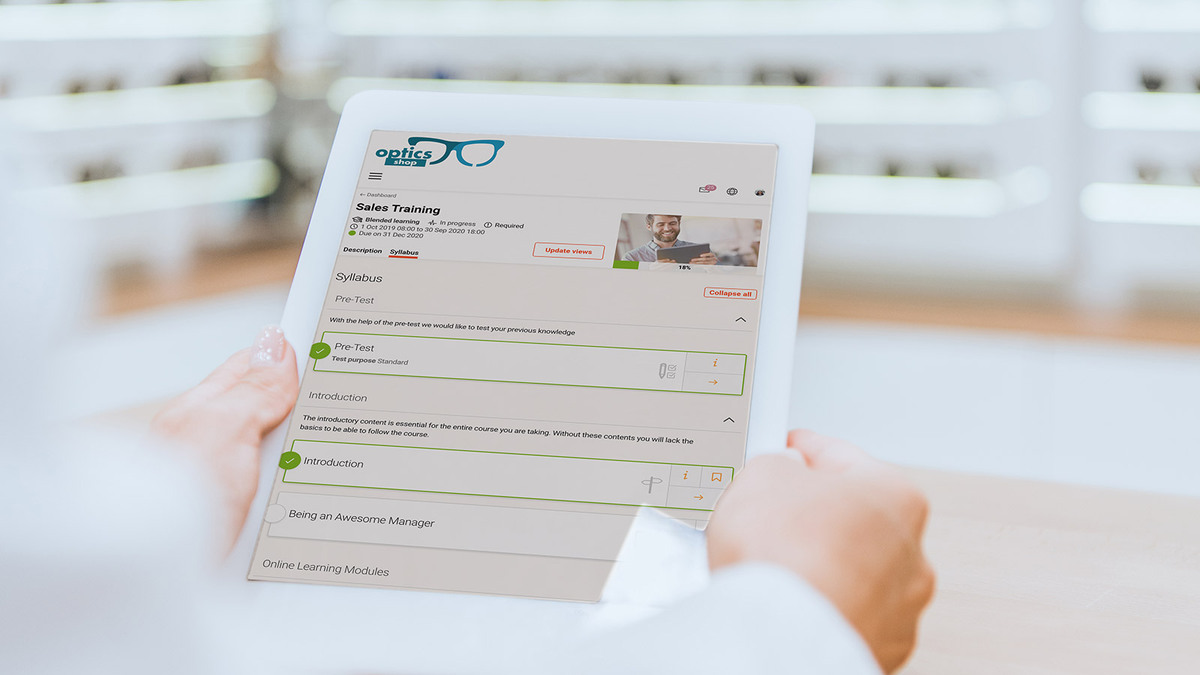
NOTE
Distributors, trading partners AND external sales people all have the same need for specialist and product knowledge. Leaving out this target group when arranging learning and development measures is a missed opportunity for significant revenue growth.
Which target group should an extended enterprise training scenario take into account?
The circle of distribution partners includes more than just external sales employees. Depending on the sector and the orientation towards B2B or B2C business, a completely different set of target groups should be addressed and included. For example:
- Distributors and dealers (car dealerships, opticians)
- Franchisees (restaurants, insurance companies, real estate agents, etc.)
- Specialist staff in the insurance, health or medical technology sectors
- Joint ventures
- Partners
- Customers
- Members and voluntary staff
- Friends and family
- The general public

Sales training for external partners: online or in person?
Once the external partner network has been defined, the question is: Is it better to train these employees online or in person? Both options have advantages and disadvantages which need to be balanced precisely. The idea to present such distributor training online – for instance, in a learning management system (LMS) – is not new.
The benefits are obvious: Instead of sales consultants travelling to attend on-site training, all employees ultimately involved in selling the product can complete relevant product training in the convenience of their home or their workplace using various devices. For instance, an optics manufacturer placing their products with various chains can provide remote access to the product training to all sales staff of those chains’ branches.
However, the drawback of such online training is that employees are often under time pressure or lack motivation to get started with such training. It is therefore crucial to minimise any barriers to entry for training measures.
For instance, complicated registration processes act as a deterrent. Combined online and face-to-face training within a hybrid learning concept or even a true blended learning scenario may also be suitable options.
Having assisted numerous imc customers with the development and support of such training, training expert Anika Rabe recommends:

Anika Rabe
“Most of the time, product training is not designed for the general public and must therefore be set in a secure area. An LMS is a suitable option for this.
Yet, the training courses must be easily accessible for everyone and, above all, they must be interesting. In particular, external employees must be involved on an emotional level rather than stopping at technical product knowledge.”

Facts tell, stories sell
No emotion – no sales. Especially when technical differences between products or brands have no major impact, brand loyalty and great storytelling are key.
An external employee needs at least the same degree of emotional investment as a team member of the manufacturer - they must both convey enthusiasm for the product. That is exactly what product training needs to deliver. Items like smartphones, jewellery or cars are frequently bought for emotional reasons, rather than based on mere facts.
If a sales consultant can share their enthusiasm for a product, customers are more likely to buy it – even if, objectively, it is not better or cheaper.

One size fits all is a thing of the past
The training that helps external partners internalise these stories differs from that most helpful to your own employees. Internal team members already have a special connection to the brand or the products. They already believe in the quality standard, and need not be won over.
This is an important aspect to take into account. One-size-fits-all solutions no longer have a place in training design – and even the best training will fail if it is unnecessarily difficult to access. This is why training expert Anika Rabe recommends: “Making it easier to access learning means making it more likely for the learning experience to be shared by everyone. For example, adding a QR code to products that are new or involve a steep learning curve is easy, and can be used to direct the user to the relevant training course with a simple scan.”
However, Anika notes that simplified access also makes it harder to verify training. If a training course requires no prior authentication, the creator of the learning content cannot know with certainty whether the end user really completed it, nor how much time they invested. It also remains unknown how much the learner actually learned, and whether they actively apply that knowledge.
Yet such assessment is important, especially when optimising and evaluating learning content. While in-depth learning analytics would be taking things too far in this context, it is a topic L&D managers should keep an eye on.
Combining both worlds to boost sales
According to Dr. Wolfram Jost, Board Member and Head of Product Management at imc, the only thing that really matters in the end is this: The learning curve must be transformed into an earning curve. No company trains employees just for fun – whether that is internal employees or external partners. Especially in the extended enterprise learningscenario, the fundamental objective is to increase the company’s sales. Partner training must contribute to corporate success.
It helps to keep these key questions in mind when designing your extended enterprise training to transform the learning outcome into revenue.
- Objective: What is the training designed to achieve?
- Target group: Who is meant to be trained? What prior knowledge does my target group have? What information and which stories do they need?
- Conceptual design: What type or combination of training is suitable?
- Performance assessment: How do I define success? How and when do I measure it?
- Training access: How can I simplify training access?
- Learner motivation: How can my training design ensure that external partners enjoy the training process and retain the learned content?

Onboarding, slightly different
Onboarding can already be integrated into an existing LMS, but this benefit is hardly ever used.
We took a little trip into the (near) future to see what a successful onboarding process could look like.

Why the gains from an LMS outweigh its costs
A Learning Management System too expensive? Not if you use it in the right way! For most clients, an LMS pays for itself within a year. We tell you how to prove that with a Business Case.

More about our LMS
If you would like to learn more about imc's Learning Management System, check here for more information.

Contact person
I have been working in the Marketing & Communication Team at imc since March 2019.
Communication, creative content and social media are my passion. "KISS - Keep it short and simple" is my credo.
To explain complex content in an understandable way and thus make the topic of e-Learning accessible to everyone is an exciting challenge every day.
Privately I love to read, play poker and travel a lot.
I am always happy to receive feedback or suggestions.

Science fiction or near future?
28% of all new recruits quit within their trial period or even fail to turn up on their first day of work. Moreover, employees who receive poor induction are twice as likely to leave as employees who go through an effective onboarding process.
These figures by Haufe should alarm companies: Faced with the ongoing “War of Talents”, new hires are extremely time consuming and costly. Yet, a well-designed onboarding concept can be integrated directly into the existing learning management system (LMS).
To many LMS managers, some of the options available today sound like science fiction. That’s why we embarked on some onboarding time travel into the near future to experience what onboarding might look like.
The first few weeks are crucial for making new colleagues feel welcome in the organisation and helping them become part of the team, as this is the foundation for long-term company loyalty. This requires both empathy and clear onboarding processes. Even larger organisations with existing learning management systems that would provide an optimal infrastructure for efficient onboarding design are often unaware of the opportunities available.
This is why we are following our fictitious employee Hanna in this article to get a glimpse of her slightly different onboarding experience ...

Hanna is excited. She just signed the contract for her new job. She is leaving the big bank where she had been involved in investment advisory services for several years and completed many professional development courses. While most of these followed the traditional face-to-face format, some were delivered online – and often bored her to death.
She will handle similar tasks in her new job with her new employer and fears that she will have to chew through the same dull content all over again. After all, that’s what happened the last time she changed jobs. She lets out a sigh at the mere thought at yet another bog-standard first aid course. Hanna has been a certified first aider and fire protection assistant for years.
Exactly two weeks before her first day at work, a friendly email lands in Hanna’s inbox, asking her to join her new employer’s in-house learning management system. She is quite unsure what to make of that. Surely, they are not expecting her to work already?
Curiosity gets the better of her – and she is in for a surprise. Instead of the expected work assignments, a chatbot welcomes her who resembles a cross between Wall-E and R2D2. The assistant introduces himself as Robby and gives Hanna a virtual tour of her new office, introduces the other team members with a picture, and shows her where they sit. He also reveals her future email address and the (mobile) devices she can expect to find on her desk on her first day.
He asks how she plans to travel to the office, and whether she prefers public transport, car or changing it up. She chooses “both” and promptly receives an overview of all connections and parking options. Robby also shows her who will be sitting at reception on her first day and issue her access card.
The little chatbot then explains which communication tools are used in the company and which other tools Hanna will be working with. She is given the option to take a closer look at these tools before starting her job, but is informed that her manager will personally show her how to use them all in her first week.
Robby ends his tour with the words: “We are looking forward to welcoming you soon. If you have any further questions, simply launch a chat and I will be happy to help you!”
The day of truth has arrived: The first day gets underway and Hanna is stumped. Armed with a smartphone, she is asked to team up with another colleague to complete some type of digital scavenger hunt through the company. When she passes certain offices, she receives a notification along the lines of: “Say Hi to Peter! Peter is responsible for your business trips and finances.”
In her new office, she meets the colleagues Robby had already introduced her to virtually, and she is asked to log into the learning management system from her workstation and complete a test. Instead of a typical mind-numbing multiple choice test, Robby greets her, guides her through the different departments and processes, and invites her to an interactive quiz. Even the training sessions on data protection, cyber security and first aid flow nicely.
When she states her qualifications as a first aider and fire protection assistant, she is asked to upload her certificate and given leave to skip all subsequent questions in this field. Robby also enquires directly whether he may add her as a first aider in the system. Hanna agrees.
The system also adapts to her current knowledge with the subsequent questions, and tailors them accordingly. When the program notices that Hanna already possesses sound knowledge in a field, it either asks more difficult questions or skips certain sections. At the end of the training session, Robby leaves her with the words: “Thank you for your support! I see you are already a real pro. I will adjust your onboarding plan and training accordingly.”
Indeed, Hanna learns only new contents in subsequent training sessions. She is asked to self-assess and is provided with a tailored concept aligned with her personal development goals. She is free to schedule her learning time at her leisure. Her superiors only set a deadline for completing all training units.
Even learning method and approach are tailored to her personal requirements. All training contents is available in various formats, and Hanna can select her preferred system. This involves no additional tests: The algorithm identifies the methods most suitable for Hanna based on the training units she has already completed, and suggests training units using a similar approach. If she doesn’t like them, she is free to switch to other formats at any time.
A few weeks into her job, Hanna suddenly stumbles on a question. She enters it on the intranet and is immediately referred to a matching training session. In addition to the specific training offer, she is also shown which colleagues could assist her with her query. Meanwhile, Hanna is shown as an expert for questions in her specialty areas.
Intuitive tools also let her create her own training sessions in minimal time. Templates are provided in the system, and she can choose between voice-to-text, typed entries, preparing presentations or creating diagrams. Content design is automated and the output is provided in a range of formats. Training is delivered in “learning nuggets”, that is smaller learning units no longer than three minutes each.
By now, Hanna’s profile is after three months filled with a wealth of information. She had already discussed the direction she would like her development to take with her manager in the initial weeks, and they identified the required competences and skills and how she can acquire them. In the next half year, she would like to further improve her English. She is also considering assuming technical management tasks.
To this end, she submitted her self-assessment which must be confirmed by her line manager. A skill profile based on this assessment was set up in the system, which shows target and actual scores. Every time Hanna creates or completes another training unit, the target score increases, and she can see which courses would help her achieve further improvements.
Hanna’s onboarding is complete after six months. She feels like she has arrived and is in good hands. Her line manager now sets up a meeting together with the head of her department. Hanna is slightly uneasy when she arrives for the meeting and wonders whether she had misjudged her achievement after all.
Instead, she finds out that a colleague in another department had unexpectedly handed in his notice. The skills match for the position showed that Hanna already met 80% of the job requirements. While she still needed training in employee management, her superiors are confident that she will master this quickly. Hanna accepts and is promoted after only half a year with the company.
...and in reality?
So far, so good. Which parts of this story are wishful thinking? Which aspects ring true in real life? No doubt, almost every scenario described is possible today - or will be very soon. Nevertheless, companies are only utilising a fraction of these options and opportunities. Creating a dedicated skills profile for each job, developing learning paths and linking these with competences or integrating learning on demand takes time. Yet, investing in these topics – also in combination with skills-based job profiles – and integrating them into the onboarding process pays off, especially when facing skills shortages.
We therefore hope that Hanna’s story leaves the realm of science fiction and becomes reality soon.
Our eBook on competency-based learning offers many helpful tips and, of course, we are happy to assist. Feel free to contact us directly on [email protected].

Courage to the LMS - even as SME!
Not only big companies should have the courage to go for a Learning Management System. In our interview Christian Mai from S&G Mercedes Benz, tells about his experiences with rolling out an LMS in a Small and Medium Enterprise (SME).

Convincing stakeholders for an LMS
The success of introducing an LMS hinges on those responsible for the launch - and not underestimating them. We have compiled some expert tips and a checklist to help you in convincing your stakeholders.

More information about the LMS
If you would like to find our more about the Learning Management System of imc, please find all information here.
Contact
I have been working in the Marketing & Communication Team at imc since March 2019.
Communication, creative content and social media are my passion. "KISS - Keep it short and simple" is my credo.
To explain complex content in an understandable way and thus make the topic of e-Learning accessible to everyone is an exciting challenge every day.
Privately I love to read, play poker and travel a lot.
I am always happy to receive feedback or suggestions.

Punky Talk #3: Katharina Kunz
The third Punky Talk is all about blended learning. We welcome our guest Katharina Kunz. As a learning strategy expert, Katharina Kunz helps companies link learning content, systems and people to create a working learning ecosystem. She is appealing to all learning and development managers not to limit professional development to invitations for 4-course meals, but also offer a 24/7 learning buffet.
In our E-Learning Punk interview, Malte had already compared a successful blended learning solution to a balanced meal. Katharina picks up the thread right there and takes it one step further. She explains why we should look at the bigger picture of blended learning – the entire learning offer, rather than just one topic – and why a buffet offers greater flexibility, enabling us to create customised learning experiences on demand.
Enjoy watching!

To watch this video, marketing cookies must be accepted. Click on the play button to accept. You can find more information in our cookie banner and in the privacy policy.
(Note: under "settings", you can turn on the English subtitles for this interview)

Blended Learning Recipe
Instructional Designer Malte Arend reveals to us what a successful Blended Learning solution has in common with the perfect pizza recipe.

Punky Talk #2: Roman Rackwitz
Roman Rackwitz hhas already been named one of the top 10 gamification experts in the world. In the E-Learning Punky Talk, he discusses game-based learning, quiz-based learning and AI.
Contact person
Since 2014 I have been part of the marketing & communication team at imc. My heart beats for creative campaigns, exciting content and digital innovations. My goal is to make digital topics understandable and simple to the point. My passions besides my job are good books and sports.
I am always happy to receive feedback on the series at [email protected].


Blended Learning Recipe
Everybody loves pizza! Crispy dough, a fresh-fruity tomato sauce, crunchy vegetables or spicy salami depending on the type and last but not least the hot, melting cheese - with pizza the best ingredients come together on a tray. The same applies to blended learning. The similarities were first recognised as a concept in 2008 by Clive Shepherd, when he likened blended learning to a balanced meal – a combination of ingredients, each with a unique purpose.

To watch this video, marketing cookies must be accepted. Click on the play button to accept. You can find more information in our cookie banner and in the privacy policy.
In our interview instructional designer Malte Arends reveals his recipe for perfect blended learning, every time
From classroom training with complementary online materials to on-the-job digital performance support - where does blended learning begin and end?
Malte: The spectrum is enormous. Basically, imagine at one end, at the beginning there could be a notification email about a new web-based training (WBT) with a stimulating question about the content. The question provides a first learning impulse. Maybe the learner does his own research before looking at the WBT - and we would have a minimal glare. At the other end of the spectrum, we would have a learning scenario with a media portal that collects a wide variety of content - videos, interviews, WBTs, curated content - and the ability for learners to contribute their own content and customise their course.
You just said it can start with an email about a WBT. But doesn't blended learning mean that digital and non-digital elements are combined?
Malte: No, not at all. Blended learning basically just means that I combine different learning formats with a very specific purpose to create a meaningful whole. With this definition a combination of different digital formats can be defined as blended too, not just scenarios with online and offline together.
The point of mixing the formats, whether digital or analogue, is that individual formats are better suited to create a certain behaviour in the learner or to make him better in a certain matter than others. For example, a checklist in Excel printed out at the point of need can be more helpful than a digital learning game, which should prepare the learner for all imaginable situations. However, this learning game could then serve another purpose particularly well.
And the mixing goes down well for learners, according to studies , three out of four learners give blended learning a like. What do you think makes blended learning so popular?
Malte: In my opinion, blended learning is so successful because - if well done - it enables people to be more successful, safer or simply more relaxed in their job. Ideally, learners receive exactly the input they need to prepare for a particular task, or they can access a resource exactly when they need it in a specific situation.
It is important that the blend is created strictly from the learner's perspective. In other words, the formats and contents must be chosen in such a way that the learners can derive real benefit from them. Otherwise, we will create metaphorical fast food – quick but lacking in nutrition or substance.
And what components should be included in every blended learning kit to provide enough variety?
Malte: (laughs) Which topping is best for the pizza? There is no general answer to this question either. In my case, chilli peppers definitely belong. For blended learning, the following applies: exactly those that fit a particular need for the learners.
This depends, among other things, on the complexity of the topic, my budget, my objectives as a company and my target group. The general answer would therefore be that formats must be included that help to achieve my performance goals and that are optimally adapted to the existing framework conditions.
Is blended learning suitable for every learning goal and scenario?
Malte: The answer is a clear yes and no. If, for example, learners need to understand a certain concept or some context, you might be able to do that well with a short video explanation. Then it might be sufficient to produce such a video. After the initial idea that a minimal blend can also be created by a stimulating mail that refers to our video, one could say that you are already blending at this point. But then you have to put up with the fact that other people might say that it's not real blended learning - just a mail and a video.
Yes, that makes sense. Let's come to the next question: "The quality of the content makes the difference regardless of the actual blended learning scenario" - yes or no?
Malte: The truth is never black or white. I answer with “No” and argue that the difference is the right combination. If the learning formats are not optimally aligned to the performance goals and framework parameters in the project, then in my opinion even the best content quality will not be convincing - and a successful learning offer will be created. A self-made video in the right blend can provide just as much of a learning stimulus as a high-quality video. But, and now I answer with “Yes”, there has to be a certain quality to be accepted by the learners. From my point of view, this is nothing else but internal marketing and appreciation for one's own employees. I have to convey my corporate values and beliefs in my learning offerings. Quality and the right blend must therefore form a symbiosis.
Which creative ideas for the implementation of blended learning come to your mind directly?
Malte: For me, everything that actually influences the employee is creative and great, inspires them to experience and try things out, and perhaps also lies off the beaten track of WBT and trainer-led learning – from the digital reference book to various video formats to face-to-face formats such as Barcamp or Brown Bag Session. Creative can , on the one hand, be the format choice itself, on the other hand of course the respective conversion of the format.
What should not be missing, in any case, is the internal communications to support the implementation! For example, posters or a small showreel that raises the target groups awareness of the learning program and communicates its benefits.
What do you have to consider when implementing a blended learning scenario? Do you have some “Do´s and Don´ts?
Malte: The outsourcing of topics to WBT is in any case a “don't”. I can't assume that I already have a great blended learning when I reduce my ten days of face-to-face training to five by offering a WBT beforehand without thinking whether or not it makes sense for me to reach my target group and my goals and so on. Another “don't” for me is to underestimate the value of internal marketing efforts. Just as I market products to sell to my customers, I must market my learning programs for my employees to learn about and understand the value of the learning opportunities.
For “do’s”, I need to start with the company's goals first, “what is they are trying to achieve?”. Then I need know who my target group is, which concrete actions they should be performing better and why this is not currently happening to the desired extent. Next, I consider the methods available to best achieve my goals and satisfy the needs of my employees within the given framework. In other words, I have to approach things systematically from the very beginning. That is a definite “do’s”!
Another “do’s”: I have to take the learner's perspective. "As an employee, I feel the need to feel good about my job. I can only feel good if I can do certain things well and avoid certain mistakes." If I understand how I can convey this feeling to employees, then I can also decide what training formats to offer these employees so that they reach this state.
Where do you think the blended learning journey will take us?
Malte: The biggest future trend, I think, will be that at some point we will no longer have rigidly defined courses and learning paths, but an offer of resources from which employees can make use of at the "moment of need". Traditional qualification strategies can also be implemented in this way with the necessary systematic support.
The success of the numerous open learning platforms on the Internet has been proof of this trend for some time now. Of course, YouTube is also at the forefront. An example: When my daughter was still lying in a pram, I had to stow the giant thing in my car to visit Grandma. I googled “How do I fold the pram so that it fits into the trunk?” with my mobile phone and relatively quickly found another father's video, watched it without logging in, and I folded the pram and stowed it away in a jiffy.
You mentioned the marketing aspect of blended learning. Do you think AI will influence blended learning as much as marketing?
Malte: Perhaps to the extent that AI can give me learning recommendations based on my interests, learning history or qualification requirements. Or can help me to find suitable learning opportunities, certainly yes.
What the L&D industry can certainly learn from marketing is to output location-triggered content. For example, with geo-targeting or beacons. This could look like the following for a car salesman: I approach a certain car with a customer, my sales tablet recognises which car I am standing next to and automatically offers me content related to that car.
Thank you Malte for the exciting interview!
The next issue of E-Learning Punk next month will be dedicated to mobile learning.
Contact person

